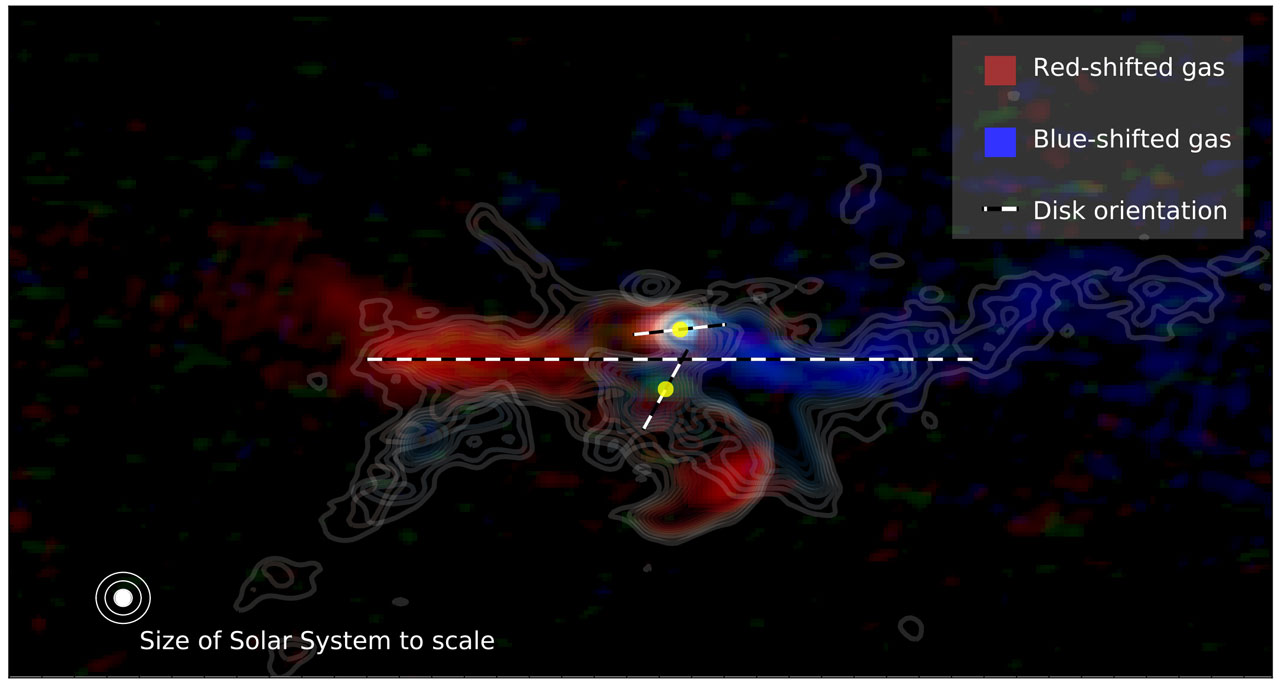
Observations with the ALMA telescopes of the gas around the two stars called IRS 43. The colours are shown as an illustration. The gas moves in orbit around the stars, which are highlighted in yellow. The gas that is moving away from us is represented by red, while the gas moving towards us is shown in blue. The positions of the discs are indicated by the dotted lines. (Credit: Christian Brinch, NBI, KU)
Researchers from the Niels Bohr Institute have discovered a system consisting of 2 stars with 3 rotating planet-forming accretion discs around them. It is a binary star where each star has its own planet-forming disc and in addition, there is one large shared disc. All 3 planet-forming discs are misaligned in relation to one another.
A solar system is formed by a large cloud of gas and dust which condenses and collapses into a ball of gas in the centre. Here the pressure heats up the matter and creates a glowing ball of gas, a star. The remainder of the gas and dust cloud rotates as a disc around the newly formed star. In this rotating disc of gas and dust, the material begins to accumulate and form larger clumps, which finally become planets. Often it is not just one, but two stars that are formed in the dense cloud of gas and dust. Binary stars are held together by their mutual gravity and orbit in a path around each other. About half of all stars are binary stars and they can each have a rotating disc of gas and dust.
“The two newly formed stars are both the size of our sun and they each have a rotating disc of gas and dust similar to the size of our solar system. In addition, they have a shared disc that is much larger and crosses over the other two discs. All three discs are staggered and this breaks with everything we have seen so far,” says Assistant Prof Christian Brinch.

A graphic illustration of the IRS 43 system showing the relative positions of the planet-forming discs. The two newly formed stars each have a rotating disc of gas and dust and also have a shared disc which is much larger and lies across the other two discs. All three discs are staggered in relation to each other. The red colour indicates the parts of the discs moving away from us, while the blue shows what is moving towards us. Photo: Christian Brinch/NBI/KU
The stars were observed with ALMA by an international team of researchers from Denmark, England and the Netherlands. The stars are about 400 light years away from the Earth,100-200,000 years old and planet formation may already have started. They cannot see this. But when they can see the accretion discs, it is because they are still mostly made up of gases.
“What we can observe is the gas itself, because the molecules are excited by the heat from the stars and therefore emit light in the infrared and microwave range. By studying the wavelength of the light you can see whether the light source is moving farther away or is getting closer. If the light shifts towards red wavelengths it is moving farther away, while blue shift light is moving closer and thus we can see that the 3 planet-forming discs are almost ‘tumbling around’ and are skewed relative to each other,” explains Christian Brinch.
The researchers do not know why it is not a ‘nice’ system where the rotating discs of gas lie flat in relation to each other. Perhaps the formation occurred in a particularly turbulent manner.
“We will use computer simulations to try to understand the physics of the formation process. Perhaps it is a dynamic process of formation, which happens often and then it corrects itself later on. We will try to clarify this. We will also apply for more observation time on the ALMA telescope to study the planet-forming discs in even higher resolution to get more detailed information about their chemical composition,” says A/prof Jes Jørgensen, Niels Bohr Institute and Centre for Star and Planet Formation, University of Copenhagen. http://www.nbi.ku.dk/english/news/news16/chaos-in-cosmos-stars-with-three-planet-forming-discs-of-gas/
http://www.ibtimes.com/irs-43-chaotic-binary-star-system-3-skewed-planet-forming-disks-2430293







Recent Comments